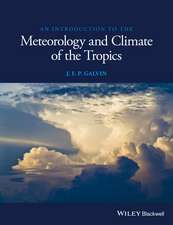Tropical Cyclones: Climatology and Impacts in the South Pacific
Autor James P. Terryen Limba Engleză Paperback – 18 oct 2010
| Toate formatele și edițiile | Preț | Express |
|---|---|---|
| Paperback (1) | 636.80 lei 6-8 săpt. | |
| Springer – 18 oct 2010 | 636.80 lei 6-8 săpt. | |
| Hardback (1) | 640.88 lei 6-8 săpt. | |
| Springer – 29 oct 2007 | 640.88 lei 6-8 săpt. |
Preț: 636.80 lei
Preț vechi: 749.19 lei
-15% Nou
Puncte Express: 955
Preț estimativ în valută:
121.86€ • 130.30$ • 101.60£
121.86€ • 130.30$ • 101.60£
Carte tipărită la comandă
Livrare economică 18 aprilie-02 mai
Preluare comenzi: 021 569.72.76
Specificații
ISBN-13: 9781441924476
ISBN-10: 1441924477
Pagini: 224
Ilustrații: XII, 212 p. 128 illus.
Dimensiuni: 155 x 235 x 12 mm
Greutate: 0.32 kg
Ediția:Softcover reprint of hardcover 1st ed. 2007
Editura: Springer
Colecția Springer
Locul publicării:New York, NY, United States
ISBN-10: 1441924477
Pagini: 224
Ilustrații: XII, 212 p. 128 illus.
Dimensiuni: 155 x 235 x 12 mm
Greutate: 0.32 kg
Ediția:Softcover reprint of hardcover 1st ed. 2007
Editura: Springer
Colecția Springer
Locul publicării:New York, NY, United States
Public țintă
ResearchCuprins
Tropical Cyclones in the South Pacific.- Setting the Scene.- Tropical Cyclogenesis.- Tropical Cyclone Structure.- Tropical Cyclone Structure.- Meteorological Conditions.- Future Tropical Cyclone Activity.- Impacts of Tropical Cyclones.- Coastal Geomorphology.- Slope Stability and Mass Movements.- River Hydrology and Floods.- Fluvial Geomorphology.
Recenzii
From the reviews:“Tropical Cyclones: Climatology and Impacts in the South Pacific describes the climatology, structure, and behavior of tropical cyclones in the South Pacific and … impacts of these storms on the physical environment of the islands in their path. … The text is … well laid out with black-and-white photographs, tables, and graphs. … appealing to students and professionals from the region. … It would be an excellent resource for climatologists and educators … . Researchers from other disciplines … will also find this volume valuable.” (Mark Sinclair, Bulletin of the American Meteorological Society, April, 2009)
Notă biografică
James Terry is Head of the Department of Geography at the University of the South Pacific (USP), Fiji Islands. Previous positions include Associate Professor at the Research Centre for the Pacific Islands, Kagoshima University, Japan. In addition to his lecture and research experience, Dr. Terry has served as a geographer consultant for various governmental institutions.
Textul de pe ultima copertă
Tropical Cyclones – Climatology and Impacts in the South Pacific
This book describes the behaviour of tropical cyclones in the South Pacific and investigates the broad range of disturbance effects these violent storms have on the physical environments of the islands that lie in their path and the people who live on them. It is the first book to link these two themes – the characteristics of cyclones and their landscape impacts.
Students of physical geography will find this book an authoritative source. It should also appeal to those concerned with climate change, extreme events, natural hazards, tropical islands, tropical geomorphology and hydrology, and to all those who have a general curiosity about the vast Oceania region and its remote, vulnerable islands.
The volume is divided into two complementary parts. The first part explains the nature of tropical cyclones, their genesis, structure, behaviour, and extreme meteorological conditions. Future cyclone activity related to climate change is also considered. Part two deals with geomorphological and hydrological responses to tropical cyclones on South Pacific islands. Attention is focused on the effects of cyclones on coral reefs, coasts, slopes and rivers, which often lead to profound landform changes and have lasting influences on both island evolution and on the lives of the Islanders.
Examples and illustrations are drawn widely from across the South Pacific. Numerous maps, informative drawings, and many spectacular photographs are used with great effect throughout, resulting in a highly readable volume.
James P. Terry is Associate Professor and former Head of the School of Geography at the University of the South Pacific in Fiji.
Cover illustration: a painting by Peni Vuniceva, well-known one-handed artist in Fiji who suffered from leprosy since childhood. The painting depicts the wrath of Tropical Cyclone Oscar inMarch 1983 lashing the island of Ovalau in Fiji, based on stories told to him by his wife who was on the island at the time.
This book describes the behaviour of tropical cyclones in the South Pacific and investigates the broad range of disturbance effects these violent storms have on the physical environments of the islands that lie in their path and the people who live on them. It is the first book to link these two themes – the characteristics of cyclones and their landscape impacts.
Students of physical geography will find this book an authoritative source. It should also appeal to those concerned with climate change, extreme events, natural hazards, tropical islands, tropical geomorphology and hydrology, and to all those who have a general curiosity about the vast Oceania region and its remote, vulnerable islands.
The volume is divided into two complementary parts. The first part explains the nature of tropical cyclones, their genesis, structure, behaviour, and extreme meteorological conditions. Future cyclone activity related to climate change is also considered. Part two deals with geomorphological and hydrological responses to tropical cyclones on South Pacific islands. Attention is focused on the effects of cyclones on coral reefs, coasts, slopes and rivers, which often lead to profound landform changes and have lasting influences on both island evolution and on the lives of the Islanders.
Examples and illustrations are drawn widely from across the South Pacific. Numerous maps, informative drawings, and many spectacular photographs are used with great effect throughout, resulting in a highly readable volume.
James P. Terry is Associate Professor and former Head of the School of Geography at the University of the South Pacific in Fiji.
Cover illustration: a painting by Peni Vuniceva, well-known one-handed artist in Fiji who suffered from leprosy since childhood. The painting depicts the wrath of Tropical Cyclone Oscar inMarch 1983 lashing the island of Ovalau in Fiji, based on stories told to him by his wife who was on the island at the time.
Caracteristici
The first book about tropical cyclones in the South Pacific, one of the main global regions where cyclones occur Brings a whole field of major new insight – explains the importance of the islands' physical environment in regard to tropical cyclones and discusses such drastic response options as alterations to river systems, slope processes and coastlines, and even island formation and/or destruction Covers the vulnerable South Pacific which includes over 15 separate island nations and territories, putting numerous countries and thousands of islands are at risk of cyclones Discusses how the South Pacific plays a major role in the phenomenon of El Nino and is the centre of attention for climate change issues, such as ocean warming and sea level rise Complements the current climate change debate








